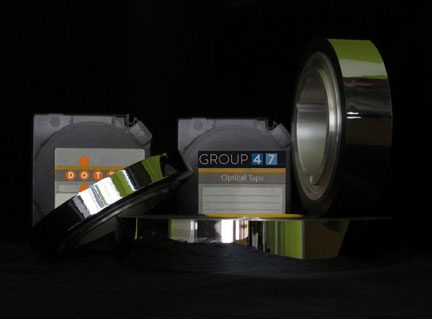‘A non-magnetic, 100 year, green solution for data storage.’
This is the stuff of digital information managers’ dreams. No more worrying about active data management, file obsolescence or that escalating energy bill.
Imagine how simple life would be if there was a way to store digital information that could last, without intervention, for nearly 100 years. Those precious digital archives could be stored in a warehouse that was not climate controlled, because the storage medium was resilient enough to withstand irregular temperatures.
Imagine after 100 years an archivist enters that very same warehouse to retrieve information requested by a researcher. The archivist pulls a box off the shelf and places it on the table. In their bag they have a powerful magnifying glass which they use to read the information. Having ascertained they have the correct item, they walk out the warehouse, taking the box with them. Later that day, instructions provided as part of the product licensing over 100 years ago are used to construct a reader that will retrieve the data. The information is recovered and, having assessed the condition of the storage medium which seems in pretty good nick, the digital optical technology storage is taken back to the warehouse where it sits for another 10 years, until it is subject to its life-cycle review.
Does this all sound too good to be true? For anyone exposed to the constantly changing world of digital preservation, the answer would almost definitely be yes. We have already covered on this blog numerous issues that the contemporary digital information manager may face. The lack of standardisation in technical practices and the bewildering array of theories about how to manage digital data mean there is currently no ‘one size fits all’ solution to tame the archive of born-digital and digitised content, which is estimated to swell to 3,000 Exabytes (thousands of petabytes) by 2020*. We have also covered the growing concerns about the ecological impact of digital technologies, such as e-waste and energy over-consumption. With this in mind, the news that a current technology exists that can by-pass many of these problems will seem like manna from heaven. What can this technology be and why have you never heard about it?
The technology in question is called DOTS, which stands for Digital Optical Technology System. The technology is owned and being developed by Group 47, who ‘formed in 2008 in order to secure the patents, designs, and manufacturing processes for DOTS, a proven 100-year archival technology developed by the Eastman Kodak Company.’ DOTS is refreshingly different from every other data storage solution on the market because it ‘eliminates media and energy waste from forced migration, costly power requirements, and rigid environmental control demands’. What’s more, DOTS are ‘designed to be “plug & play compatible” with the existing Linear Tape Open (LTO) tape-based archiving systems & workflow’.
In comparison with other digital information management systems that can employ complex software, the data imaged by DOTS does not use sophisticated technology. John Lafferty writes that at ‘the heart of DOTS technology is an extremely stable storage medium – metal alloy sputtered onto mylar tape – that undergoes a change in reflectivity when hit by a laser. The change is irreversible and doesn’t alter over time, making it a very simple yet reliable technology.’
DOTS can survive the benign neglect all data experiences over time, but can also withstand pretty extreme neglect. During research and development, for example, DOTS was exposed to a series of accelerated environmental age testing that concluded ‘there was no discernible damage to the media after the equivalent of 95.7 years.’ But the testing did not stop there. Since acquiring patents for the technology Group 47,
‘has subjected samples of DOTS media to over 72 hours of immersion each in water, benzine, isopropyl alcohol, and Clorox (™) Toilet Bowl Cleaner. In each case, there was no detectable damage to the DOTS media. However, when subjected to the citric acid of Sprite carbonated beverage, the metal had visibly deteriorated within six hours.’
Robust indeed! DOTS is also non-magnetic, chemically inert, immune from electromagnetic fields and can be stored in normal office environments or extremes ranging from -9º – 65º C. It ticks all the boxes really.
DOTS vs the (digital preservation) world
The only discernible benefit of the ‘open all hours’, random access digital information culture over a storage solution such as DOTS is accessibility. While it certainly is amazing how quick and easy it is to retrieve valuable data at the click of a button, it perhaps should not be the priority when we are planning how to best take care of the information we create, and are custodians of. The key words here are valuable data. Emerging norms in digital preservation, which emphasise the need to always be responsive to technological change, takes gambles with the very digital information it seeks to preserve because there is always a risk that migration will compromise the integrity of data.
The constant management of digital data is also costly, disruptive and time-consuming. In the realm of cultural heritage, where organisations are inevitably under resourced, making sure your digital archives are working and accessible can sap energy and morale. These issues of course affect commercial organisations too. The truth is the world is facing an information epidemic, and surely we would all rest easier if we knew our archives were safe and secure. Indeed, it seems counter-intuitive that amid the endless flashy devices and research expertise in the world today, we are yet to establish sustainable archival solutions for digital data.

Of course, using a technology like DOTS need not mean we abandon the culture of access enabled by file-based digital technologies. It may however mean that the digital collections available on instant recall are more carefully curated. Ultimately we have to ask if privileging the instant access of information is preferable to long-term considerations that will safeguard cultural heritage and our planetary resources.
If such a consideration errs on the side of moderation and care, technology’s role in shaping that hazy zone of expectancy known as ‘the future’ needs to shift from the ‘bigger, faster, quicker, newer’ model, to a more cautious appreciation of the long-term. Such an outlook is built-in to the DOTS technology, demonstrating that to be ‘future proof’ a technology need not only withstand environmental challenges, such as flooding or extreme temperature change, but must also be ‘innovation proof’ by being immune to the development of new technologies. As John Lafferty writes, the license bought with the product ‘would also mandate full backward compatibility to Generation Zero, achievable since readers capable of reading greater data densities should have no trouble reading lower density information.’ DOTS also do not use propriety codecs, as Chris Castaneda reports, ‘the company’s plan is to license the DOTS technology to manufacturers, who would develop and sell it as a non-proprietary system.’ Nor do they require specialist machines to be read. With breathtaking simplicity, ‘data can be recovered with a light and a lens.’
It would be wrong to assume that Group 47’s development of DOTS is not driven by commercial interests – it clearly is. DOTS do however seem to solve many of the real problems that currently afflict the responsible and long-term management of digital information. It will be interesting to see if the technology is adopted and by who. Watch this space!
* According to a 2011 Enterprise Strategy Group Archive TCO Study

